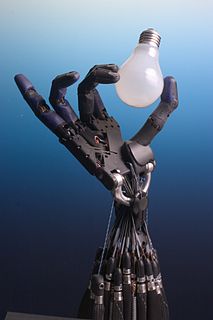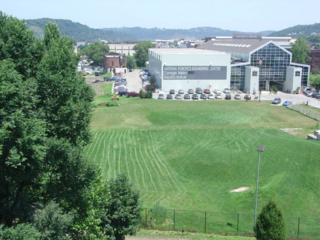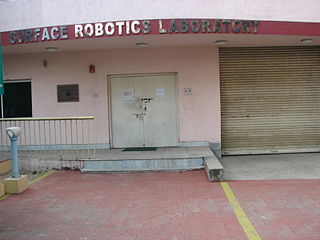Related Research Articles

An optical mouse is a computer mouse which uses a light source, typically a light-emitting diode (LED), and a light detector, such as an array of photodiodes, to detect movement relative to a surface. Variations of the optical mouse have largely replaced the older mechanical mouse design, which uses moving parts to sense motion.

The Nomad rover is an unmanned vehicle designed as a test for such a vehicle to ride on other planets.
Draper Laboratory is an American not-for-profit research and development organization, headquartered in Cambridge, Massachusetts; its official name is The Charles Stark Draper Laboratory, Inc. The laboratory specializes in the design, development, and deployment of advanced technology solutions to problems in national security, space exploration, health care and energy.
Robotic mapping is a discipline related to computer vision and cartography. The goal for an autonomous robot is to be able to construct a map or floor plan and to localize itself and its recharging bases or beacons in it. Robotic mapping is that branch which deals with the study and application of ability to localize itself in a map / plan and sometimes to construct the map or floor plan by the autonomous robot.

The Denning Mobile Robot Company of Boston was the first company to offer ready-made autonomous robots that were subsequently purchased primarily by researchers. Grinnell More's Real World Interface, Inc. (RWI) and James Slater's Nomadic Technologies (US), along with Francesco Mondada's K-Team (Switzerland), were other pioneering companies in this field, addressing the need for ready-made robots for use by robotics researchers. RWI created the B-21, Nomadic the XR4000, whilst the tiny Khepera mobile robot emerged from the stables of the Swiss K-Team. However, the high price of these machines meant that only a few graduate students and military researchers could afford them. Eventually, the low-cost Pioneer robot was introduced in 1995, a project that expanded research in mobile robotics due to the affordable price.

A mobile robot is a robot that is capable of locomotion. Mobile robotics is usually considered to be a subfield of robotics and information engineering.
An active suspension is a type of automotive suspension on a vehicle. It uses an onboard system to control the vertical movement of the vehicle's wheels relative to the chassis or vehicle body rather than the passive suspension provided by large springs where the movement is determined entirely by the road surface. So-called active suspensions are divided into two classes: real active suspensions, and adaptive or semi-active suspensions. While adaptive suspensions only vary shock absorber firmness to match changing road or dynamic conditions, active suspensions use some type of actuator to raise and lower the chassis independently at each wheel.

Turtles are a class of educational robots designed originally in the late 1940s and used in computer science and mechanical engineering training. These devices are traditionally built low to the ground with a roughly hemispheric shell and a power train capable of a very small turning radius. The robots are often equipped with sensor devices which aid in avoiding obstacles and, if the robot is sufficiently sophisticated, allow it some perception of its environment. Turtle robots are commercially available and are common projects for robotics hobbyists.

The Player Project is a project to create free software for research into robotics and sensor systems. Its components include the Player network server and the Stage robot platform simulators. Although accurate statistics are hard to obtain, Player is one of the most popular open-source robot interfaces in research and post-secondary education. Most of the major intelligent robotics journals and conferences regularly publish papers featuring real and simulated robot experiments using Player and Stage.

Legged robots are a type of mobile robot, which use articulated limbs, such as leg mechanisms, to provide locomotion. They are more versatile than wheeled robots and can traverse many different terrains, though these advantages require increased complexity and power consumption. Legged robots often imitate legged animals, such as humans or insects, in an example of biomimicry.
For any mobile device, the ability to navigate in its environment is important. Avoiding dangerous situations such as collisions and unsafe conditions comes first, but if the robot has a purpose that relates to specific places in the robot environment, it must find those places. This article will present an overview of the skill of navigation and try to identify the basic blocks of a robot navigation system, types of navigation systems, and closer look at its related building components.

Robotics is an interdisciplinary research area at the interface of computer science and engineering. Robotics involves design, construction, operation, and use of robots. The goal of robotics is to design intelligent machines that can help and assist humans in their day-to-day lives and keep everyone safe. Robotics draws on the achievement of information engineering, computer engineering, mechanical engineering, electronic engineering and others.

An inertial navigation system (INS) is a navigation device that uses a computer, motion sensors (accelerometers) and rotation sensors (gyroscopes) to continuously calculate by dead reckoning the position, the orientation, and the velocity of a moving object without the need for external references. Often the inertial sensors are supplemented by a barometric altimeter and occasionally by magnetic sensors (magnetometers) and/or speed measuring devices. INSs are used on mobile robots and on vehicles such as ships, aircraft, submarines, guided missiles, and spacecraft. Other terms used to refer to inertial navigation systems or closely related devices include inertial guidance system, inertial instrument, inertial measurement unit (IMU) and many other variations. Older INS systems generally used an inertial platform as their mounting point to the vehicle and the terms are sometimes considered synonymous.
Almost Human: Making Robots Think is a book written by Lee Gutkind founder of Creative Nonfiction. Gutkind spent six years as a "fly on the wall" researcher at the Robotics Institute at Carnegie-Mellon University in Pittsburgh. He observed scientists and students working to design, build, and test robots so advanced that they will one day be able to work alongside or, in some cases, even replace humans. Almost Human is an intense portrait of the robotic subculture and the challenging quest for robot autonomy. Almost Human is 330 pages long and is published by W.W. Norton. In May 2007 Gutkind appeared as a guest author on The Daily Show with Jon Stewart to talk about robots, the future, and his book.

A robotic vacuum cleaner, often called a roomba, is an autonomous robotic vacuum cleaner which has intelligent programming and a limited vacuum floor cleaning system. The original design included manual operation via remote control and a "self-drive" mode which allowed the machine to clean autonomously without human control. Some designs use spinning brushes to reach tight corners, and some include a number of cleaning features along with the vacuuming feature.
CajunBot refers to the autonomous ground vehicles developed by the University of Louisiana at Lafayette for the DARPA Grand Challenges. CajunBot was featured on CNN and on the Discovery Channel science series Robocars.
Robotic sensing is a subarea of robotics science intended to give robots sensing capabilities, so that robots are more human-like. Robotic sensing mainly gives robots the ability to see, touch, hear and move and uses algorithms that require environmental feedback.

The National Robotics Engineering Center (NREC) is an operating unit within the Robotics Institute (RI) of Carnegie Mellon University. NREC works closely with government and industry clients to apply robotic technologies to real-world processes and products, including unmanned vehicle and platform design, autonomy, sensing and image processing, machine learning, manipulation, and human–robot interaction.

Baxter is an industrial robot built by Rethink Robotics, a start-up company founded by Rodney Brooks. Baxter was introduced in September 2011, and was succeeded by the robot Sawyer. Baxter is a two-armed robot with an animated face. It is 3 feet tall and weighs 165 lbs without its pedestal; with its pedestal it is between 5'10" – 6'3" tall and weighs 306 lbs. It is used for simple industrial jobs such as loading, unloading, sorting, and handling of materials. Brooks stated that Baxter was designed to perform the dull tasks on a production line. It is intended to be sold to small and medium-sized companies.

Surface Robotics Laboratory is one of the major R & D Groups in the field of Robotics in Central Mechanical Engineering Research Institute. This group is actively engaged in the development of experimental mobile robots for various unconventional applications.
References
- ↑ "Nomadic FAQ". Nomadics Robot Software and Hardware Support. Retrieved 2010-08-25.
- 1 2 Pichler, Franz; Moreno-Diaz, Roberto; Kopacek, Peter (2007). Computer Aided Systems Theory - EUROCAST'99: A Selection of Papers from the 7th International Workshop on Computer Aided Systems Theory Vienna, Austria, September 29 - October 2, 1999 Proceedings . Berlin: Springer. pp. 18. ISBN 3-540-67822-0.
- 1 2 "robotics-faq/part3". Carnegie Mellon University School of Computer Science. 12 December 1994. Retrieved 2010-08-25.
- ↑ "Nomad 200". Center for Advanced Technology. Archived from the original on 2010-06-12. Retrieved 2010-08-25.
- ↑ Leondes, Cornelius T. (2018-10-08). Intelligent Systems: Technology and Applications, Six Volume Set. Boca Raton, FL: CRC Press. p. 378. ISBN 978-1-4200-4081-4.
- ↑ Computer Graphics: Developments in Virtual Environments. London: Academic Press. 2014. p. 375. ISBN 978-1-4832-9745-3.
- ↑ "The Nomad 200". Stanford University Knowledge Systems AI Laboratory. 1 November 1994. Retrieved 2010-08-25.
| This robotics-related article is a stub. You can help Wikipedia by expanding it. |